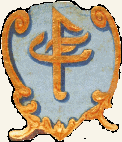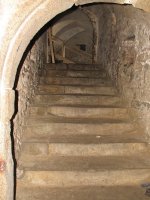Introduction
 The Cistercian Abbeys Vyšší Brod (Hohenfurth) and Osek (Osegg) in Bohemia are the last of the numerous Cistercian monasteries that once existed in the historical lands of the present-day Czech Republic, i.e. Bohemia and Moravia. Their cultural impact is inseparable from the history of these lands. In the order of their dates of foundation, there were the following Cistercian men’s monasteries in Bohemia and Moravia: Sedlec (German: Sedletz) 1143, Plasy (Plass) 1145, Nepomuk 1145, Svaté Pole (Heiligenfeld, Sacer Campus) 1157, Mnichovo Hradiště (Münchengrätz) 1177, Osek (Osegg) 1194, Velehrad (Welehrad) 1205, Žďár (Saar, Fons S. Mariae) 1240, Vyšší Brod ( Hohenfurth) 1259, Vizovice (Wisowitz, Rosa Mariae) 1261, Zlatá Koruna (Goldenkron, Sancta Spinea Corona) 1263, Zbraslav (Königsaal, Aula Regia) 1292 and Skalice (Skalitz) 1337.
The Cistercian Abbeys Vyšší Brod (Hohenfurth) and Osek (Osegg) in Bohemia are the last of the numerous Cistercian monasteries that once existed in the historical lands of the present-day Czech Republic, i.e. Bohemia and Moravia. Their cultural impact is inseparable from the history of these lands. In the order of their dates of foundation, there were the following Cistercian men’s monasteries in Bohemia and Moravia: Sedlec (German: Sedletz) 1143, Plasy (Plass) 1145, Nepomuk 1145, Svaté Pole (Heiligenfeld, Sacer Campus) 1157, Mnichovo Hradiště (Münchengrätz) 1177, Osek (Osegg) 1194, Velehrad (Welehrad) 1205, Žďár (Saar, Fons S. Mariae) 1240, Vyšší Brod ( Hohenfurth) 1259, Vizovice (Wisowitz, Rosa Mariae) 1261, Zlatá Koruna (Goldenkron, Sancta Spinea Corona) 1263, Zbraslav (Königsaal, Aula Regia) 1292 and Skalice (Skalitz) 1337. Of these men’s monasteries, ten were situated in Bohemia and three (Velehrad, Žďár and Vizovice) in Moravia. Four of these monasteries went out of existence in the course of the Hussite wars or as a consequence of the general destruction suffered in these wars: Svaté Pole, Mnichovo Hradiště, Nepomuk and Vizovice. Seven of the monasteries were abolished as a result of the Josephine attack against monasteries, which was especially drastic in Bohemia and Moravia: Sedlec, Zlatá Koruna, Zbraslav, Plasy, Žďár, Skalice and Velehrad. As a result, not a single men’s monastery remained in Czech territory. All Benedictines, Carthusians and hermits were abolished. The two remaining monasteries of the Cistercian Order, Osek and Vyšší Brod, were abolished by the communist government of the Czechoslovak Socialist Republic. Vyšší Brod had actually been abolished in 1941, due to the fact that the Czech Lands were part of the Third Reich for the duration of World War II. At one time, there were three Cistercian monasteries on the Vltava River: Vyšší Brod on the upper Vltava, Zlatá Koruna on the middle Vltava between Český Krumlov and České Budějovice, situated approximately on what was then the linguistic border, and Zbraslav on the lower Vltava, just a few kilometres from Prague.
Of these men’s monasteries, ten were situated in Bohemia and three (Velehrad, Žďár and Vizovice) in Moravia. Four of these monasteries went out of existence in the course of the Hussite wars or as a consequence of the general destruction suffered in these wars: Svaté Pole, Mnichovo Hradiště, Nepomuk and Vizovice. Seven of the monasteries were abolished as a result of the Josephine attack against monasteries, which was especially drastic in Bohemia and Moravia: Sedlec, Zlatá Koruna, Zbraslav, Plasy, Žďár, Skalice and Velehrad. As a result, not a single men’s monastery remained in Czech territory. All Benedictines, Carthusians and hermits were abolished. The two remaining monasteries of the Cistercian Order, Osek and Vyšší Brod, were abolished by the communist government of the Czechoslovak Socialist Republic. Vyšší Brod had actually been abolished in 1941, due to the fact that the Czech Lands were part of the Third Reich for the duration of World War II. At one time, there were three Cistercian monasteries on the Vltava River: Vyšší Brod on the upper Vltava, Zlatá Koruna on the middle Vltava between Český Krumlov and České Budějovice, situated approximately on what was then the linguistic border, and Zbraslav on the lower Vltava, just a few kilometres from Prague.  Vyšší Brod, the southernmost settlement of the Czech Republic, which was endowed with town rights since 1870 and had a population of about 2,500 until the German population was expelled, lies just a few kilometres from the Austrian border. It is also the last parish on the border, while the parish and market town of Bad Leonfelden on the opposite side of the border has been in the care of the Cistercian order since historical records were kept. The town lies half concealed in a flat basin, surrounded by the mountains of the southern Bohemian Forest, reaching up to an altitude of 1000 meters in that area. Somewhat separated on a low rock ledge up the river, stands the monastery Vyšší Brod on the Vltava, which, having descended from the rocks and forests of the Bohemian Forest in the north-west, changes its course and continues northwards directly through the middle of Bohemia.
Vyšší Brod, the southernmost settlement of the Czech Republic, which was endowed with town rights since 1870 and had a population of about 2,500 until the German population was expelled, lies just a few kilometres from the Austrian border. It is also the last parish on the border, while the parish and market town of Bad Leonfelden on the opposite side of the border has been in the care of the Cistercian order since historical records were kept. The town lies half concealed in a flat basin, surrounded by the mountains of the southern Bohemian Forest, reaching up to an altitude of 1000 meters in that area. Somewhat separated on a low rock ledge up the river, stands the monastery Vyšší Brod on the Vltava, which, having descended from the rocks and forests of the Bohemian Forest in the north-west, changes its course and continues northwards directly through the middle of Bohemia.
